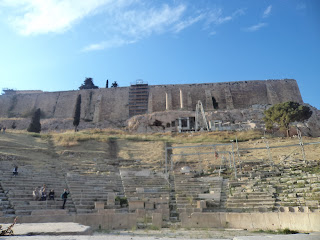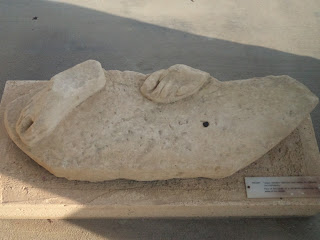Athens city world heritage monuments. Athens is full of antiquities. Each ancient stone statue is through fascinating myths and history. Stones, myths, monuments are scattered here and there..
Sanctuary of Dionysus Eleftherios and hospital of Asclepius (south slope)
The south slope of Acropolis was home to two of the most important sanctuaries of the city, those of Dionysos Eleuthereus and Asklepios. It was also the site of several other temples, smaller in size yet of great importance to the Athenians. The temple of Dionysos Eleuthereus was the site of the Great or City Dionysia, one of the most important festivals in town, which took place in the beginning of spring (in the month of Elaphebolion). It was from the cult of Dionysos, the god of wine, intoxication and ecstatic dance, that the theatre was born. On the slope above the sanctuary, the plays of the most important ancient Greek tragic and comic playwrights, Aeschylus, Sophokles, Euripides and Aristophanes were performed for the first time.
The sanctuary and associated healing centre of Asklepios in Athens was founded on the south slope of the Acropolis, through the initiative of Telemachos, an Athenian citizen who, in 420/19 BC. Brought a statue of the god from the great sanctuary of Epidaurus. In a stoa beside the sanctuary, patients lay in wait for the miraculous cure by the apparition of the god in their dreams. The numerous votive offerings, often with depictions of the body parts that the god healed, provide evidence of the great importance the god cult had for the Athenians....
THE ANCIENT THEATER OF DIONYSUS
Directions: Enter the archeological area on the southern slope of the Acropolis (entrance at Diosyssiou Aeropagitou Str), and head upwards.
On the slope to your right is the most ancient theatre of the word, the Theatre of Dionyssos.
In this theatre, the most famous ancient Greek poets, Aeschylous, Aristophanes, Euripides, and Sophocles saw premiere performances of their plays in the 5th century BC.
The auditorium and the proscenium were made of wood. In the 4th century BC they were reconstructed using marble. Section of the stone auditorium survie.
According to experts the theather had a capacity of 17.000 seats.
On the slope overlooking the theatre, sculpted on the rock of the Acropolis, is the chorec Monument of Thasyllus (319 BC) and two choregic Corinthian columns..
SOUTH ACROPOLIS:
At short distance from the sanctuary of the Asclepios was a small open-air sanctuary dedicated to the Nymphe, who was the protectress of marriage and wedding ceremonies. There the Athenians dedicated the nuptial bath vases or the loutrophoroi as well other votive offerings (perfume, bottles, cosmetics and jewelry containers , spindle-whoris, symposium vases. Figurines, female protomes and painted plaques).
The loutrophoroi were luxury vases painted in the red or black figure technique. Their decorative motifs were related to marriage and reflected the style prelevant at the time. The earlier vases depicted wedding processions, animals and mythical creatures.
These were enriched, later on, with themes and scenes from mythology, which were directly associated with the three-day long wedding festivities, the procession of women who carried the water for the nuptial bath in the loutrophroi, the adornment of the bride.
The meeting of the couple, the transfer of the newlyweds to the groom’s house, and the offering of the gifts to the bride.
The south slope was also dedicated to the cults of the Nymphs and Pan, Aphrodite, Hermes and Isis.
Aphrodite was worshipped in her capacity as Pandemos on the southwest slope as Ourania on the north.
Aphrodite Ourania was the protector of all kinds of unions, as that as marriage, while Aphrodite Pandemos was the protector of All Attic demoi (subdivisions of Attica).
The age-old cult of fertile nature developed at the temple of Ge Kourotrophos and Demeter Chioe, on the south slope. The local cult of the Hero on Bloute (bloute=luxury sandal) at the same site was probably associated with Aphrodite.
For further information please ask reception how to get to these points of mythology by the Acropolis Hill.
(English free copy text of the Greek Ministry of Tourism).
ΑΝΟΙΞΗ ΜΕ ΑΡΩΜΑ ΧΑΜΟΜΗΛΙΟΥ
‘Ηρθες Οιδίποδα στην εύιππη
όμορφη χώρα μας
Στον λαμπρό Κολωνό όπου
Γλυκοθλιμμένα καλαηδούν
Τα αηδόνια καταφεύγοντας
Στα πράσινα κλαδιά
Μες στου κισσού τα’ απόκρυφα,
Στο άβατο άλσος του θεού το μυριόκαρπο
Το ολόγιομο δροσιά
Που δεν το δέρνει ο άνεμος
Ούτε βαρύς χειμώνας.
Εδώ μεθάει ο Διόνυσος και τριγυρνάει
Οργιάζοντας παρέα με τις Βάκχες..
Μήπως είναι ο ίδιος ο Σοφοκλής απαγγέλων κομματάκι από το έργο του «Οιδίπους επί Κολωνώ»;
XR.
Sanctuary of Dionysus Eleftherios and hospital of Asclepius (south slope)
The south slope of Acropolis was home to two of the most important sanctuaries of the city, those of Dionysos Eleuthereus and Asklepios. It was also the site of several other temples, smaller in size yet of great importance to the Athenians. The temple of Dionysos Eleuthereus was the site of the Great or City Dionysia, one of the most important festivals in town, which took place in the beginning of spring (in the month of Elaphebolion). It was from the cult of Dionysos, the god of wine, intoxication and ecstatic dance, that the theatre was born. On the slope above the sanctuary, the plays of the most important ancient Greek tragic and comic playwrights, Aeschylus, Sophokles, Euripides and Aristophanes were performed for the first time.
The sanctuary and associated healing centre of Asklepios in Athens was founded on the south slope of the Acropolis, through the initiative of Telemachos, an Athenian citizen who, in 420/19 BC. Brought a statue of the god from the great sanctuary of Epidaurus. In a stoa beside the sanctuary, patients lay in wait for the miraculous cure by the apparition of the god in their dreams. The numerous votive offerings, often with depictions of the body parts that the god healed, provide evidence of the great importance the god cult had for the Athenians....
THE ANCIENT THEATER OF DIONYSUS
Directions: Enter the archeological area on the southern slope of the Acropolis (entrance at Diosyssiou Aeropagitou Str), and head upwards.
On the slope to your right is the most ancient theatre of the word, the Theatre of Dionyssos.
In this theatre, the most famous ancient Greek poets, Aeschylous, Aristophanes, Euripides, and Sophocles saw premiere performances of their plays in the 5th century BC.
The auditorium and the proscenium were made of wood. In the 4th century BC they were reconstructed using marble. Section of the stone auditorium survie.
According to experts the theather had a capacity of 17.000 seats.
On the slope overlooking the theatre, sculpted on the rock of the Acropolis, is the chorec Monument of Thasyllus (319 BC) and two choregic Corinthian columns..
SOUTH ACROPOLIS:
At short distance from the sanctuary of the Asclepios was a small open-air sanctuary dedicated to the Nymphe, who was the protectress of marriage and wedding ceremonies. There the Athenians dedicated the nuptial bath vases or the loutrophoroi as well other votive offerings (perfume, bottles, cosmetics and jewelry containers , spindle-whoris, symposium vases. Figurines, female protomes and painted plaques).
The loutrophoroi were luxury vases painted in the red or black figure technique. Their decorative motifs were related to marriage and reflected the style prelevant at the time. The earlier vases depicted wedding processions, animals and mythical creatures.
These were enriched, later on, with themes and scenes from mythology, which were directly associated with the three-day long wedding festivities, the procession of women who carried the water for the nuptial bath in the loutrophroi, the adornment of the bride.
The meeting of the couple, the transfer of the newlyweds to the groom’s house, and the offering of the gifts to the bride.
The south slope was also dedicated to the cults of the Nymphs and Pan, Aphrodite, Hermes and Isis.
Aphrodite was worshipped in her capacity as Pandemos on the southwest slope as Ourania on the north.
Aphrodite Ourania was the protector of all kinds of unions, as that as marriage, while Aphrodite Pandemos was the protector of All Attic demoi (subdivisions of Attica).
The age-old cult of fertile nature developed at the temple of Ge Kourotrophos and Demeter Chioe, on the south slope. The local cult of the Hero on Bloute (bloute=luxury sandal) at the same site was probably associated with Aphrodite.
For further information please ask reception how to get to these points of mythology by the Acropolis Hill.
(English free copy text of the Greek Ministry of Tourism).
ΑΝΟΙΞΗ ΜΕ ΑΡΩΜΑ ΧΑΜΟΜΗΛΙΟΥ
Το άρωμα του χαμομηλιού είναι έντονο και μαγευτικό. Πλημυρίζει και την Διονυσίου Αρεοπαγίτου ακόμη. Σπαρμένο από τα πουλιά και τον άνεμο στη νότιοανατολική κλιτή του λόφου της Ακροπόλεως επαναλαμβάνει κάθε χρόνο την ταπεινή του παρουσία την άνοιξη σε κάθε σημείο που του επιτρέπεται. Απομεινάρια μαρμάρων, τειχών, λίθων, βάσεων αγαλμάτων, αγαλμάτων αλλά και ένα μεγάλο μέρος από το πιο παλιό και ονομαστό θέατρο του κόσμου το ΘΕΑΤΡΟ ΔΙΟΝΥΣΟΥ κείτονται αμίλητα προκαλώντας στον επισκέπτη την αφήγηση της διαχρονικής τους περιπέτειας και μάλιστα στη γλώσσα του. Ο ελληνικός πολιτισμός στο σημείο αυτό έστω και λαβωμένος από το χρόνο και το άγριο χέρι ανθρώπων(;) επιβιώνει.. Στέκεται, ανασαίνει, εκπλήσσει, διδάσκει, συνομιλεί, διαμηνύει, φωτίζει και ποτίζει.. Αναγνωρίζεται ως πνεύμα αιώνιο που δεν υποτάσσεται.. Μας προσκαλεί και προκαλεί.. ακολουθήστε τώρα ένα φωτογραφικό ερασιτεχνικό μονοπάτι και κλείστε τα μάτια για λίγο.. Ίσως το πνεύμα σας συναντηθεί με ένα σαν και αυτό από τους διασημότερους τραγικούς συγγραφείς του κόσμου.. και τον ακούσει να λέει..:
‘Ηρθες Οιδίποδα στην εύιππη
όμορφη χώρα μας
Στον λαμπρό Κολωνό όπου
Γλυκοθλιμμένα καλαηδούν
Τα αηδόνια καταφεύγοντας
Στα πράσινα κλαδιά
Μες στου κισσού τα’ απόκρυφα,
Στο άβατο άλσος του θεού το μυριόκαρπο
Το ολόγιομο δροσιά
Που δεν το δέρνει ο άνεμος
Ούτε βαρύς χειμώνας.
Εδώ μεθάει ο Διόνυσος και τριγυρνάει
Οργιάζοντας παρέα με τις Βάκχες..
Μήπως είναι ο ίδιος ο Σοφοκλής απαγγέλων κομματάκι από το έργο του «Οιδίπους επί Κολωνώ»;
XR.




































































































































Δεν υπάρχουν σχόλια:
Δημοσίευση σχολίου
Σημείωση: Μόνο ένα μέλος αυτού του ιστολογίου μπορεί να αναρτήσει σχόλιο.